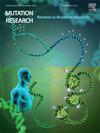Evaluation of the simultaneous effects of KRAS G12V and LCS6 alterations on the behavior of head and neck squamous cell carcinoma
IF 1.5
4区 医学
Q4 BIOTECHNOLOGY & APPLIED MICROBIOLOGY
Mutation Research-Fundamental and Molecular Mechanisms of Mutagenesis
Pub Date : 2025-01-01
DOI:10.1016/j.mrfmmm.2024.111895
引用次数: 0
Abstract
Background
Head and neck squamous cell carcinomas are the seventh most common cancer accounting for 90 % of malignant neoplasia of the upper respiratory system. KRAS is a very important oncogene, leading to the suppression of apoptosis, and promoting the pathogenesis and development of tumors. MicroRNAs (miRNAs) are highly conserved, small noncoding RNA molecules aberrantly expressed in various pathologies including regulation of tumor and metastasis-associated genes. Variant (rs61764370) of the let-7 miRNA complementary site of KRAS 3’-untranslated region (KRAS-LCS6) has been shown to disrupt the ability of miRNAs to target genes resulting in differential target mRNA and protein expression.
Methods
In this study, the effects of variant complementary site LCS6 of the let-7 miRNA in head and neck cancer were investigated in vitro using laryngeal carcinoma HEp-2 carrying G12V and LCS6 alterations in the KRAS gene. Non-cancer HEK-293 cells were also used as control cells.
Results
G12V mutation in the KRAS gene increases invasion capacity and is specifically active on the ERK pathway associated with metastasis. Alteration in the LCS6 region of the KRAS gene did not show additional effects compared to cells only carrying G12V mutation. Our results also showed that the coexistence of G12V and LCS6 alterations is lethal to specific cell types, UM-SCC-17A laryngeal cancer cells in our case.
Conclusions
The LCS6 region alteration of the KRAS may play a key role in further cancer progression, and more research is needed to fully understand the mechanisms by which the LCS6 alterations promote cancer progression.
评估 KRAS G12V 和 LCS6 改变同时对头颈部鳞状细胞癌行为的影响。
背景:头颈部鳞状细胞癌是第七大常见癌症,占上呼吸道恶性肿瘤的90% %。KRAS是一种非常重要的致癌基因,可以抑制细胞凋亡,促进肿瘤的发生发展。MicroRNAs (miRNAs)是高度保守的小非编码RNA分子,在多种病理中异常表达,包括肿瘤和转移相关基因的调控。KRAS 3'-非翻译区(KRAS- lcs6)的let-7 miRNA互补位点的变体(rs61764370)已被证明可以破坏miRNA靶向基因的能力,导致靶mRNA和蛋白的差异表达。方法:本研究采用喉癌HEp-2携带G12V和LCS6 KRAS基因改变的方法,体外研究let-7 miRNA变异互补位点LCS6在头颈癌中的作用。非癌性HEK-293细胞也作为对照细胞。结果:KRAS基因的G12V突变增加了侵袭能力,并在与转移相关的ERK通路上特别活跃。与仅携带G12V突变的细胞相比,KRAS基因LCS6区域的改变没有显示出额外的影响。我们的研究结果还表明,G12V和LCS6的共存改变对特定的细胞类型是致命的,在我们的病例中是UM-SCC-17A喉癌细胞。结论:KRAS的LCS6区域改变可能在癌症进一步进展中发挥关键作用,需要更多的研究来充分了解LCS6改变促进癌症进展的机制。
本文章由计算机程序翻译,如有差异,请以英文原文为准。
求助全文
约1分钟内获得全文
求助全文
来源期刊
CiteScore
4.90
自引率
0.00%
发文量
24
审稿时长
51 days
期刊介绍:
Mutation Research (MR) provides a platform for publishing all aspects of DNA mutations and epimutations, from basic evolutionary aspects to translational applications in genetic and epigenetic diagnostics and therapy. Mutations are defined as all possible alterations in DNA sequence and sequence organization, from point mutations to genome structural variation, chromosomal aberrations and aneuploidy. Epimutations are defined as alterations in the epigenome, i.e., changes in DNA methylation, histone modification and small regulatory RNAs.
MR publishes articles in the following areas:
Of special interest are basic mechanisms through which DNA damage and mutations impact development and differentiation, stem cell biology and cell fate in general, including various forms of cell death and cellular senescence.
The study of genome instability in human molecular epidemiology and in relation to complex phenotypes, such as human disease, is considered a growing area of importance.
Mechanisms of (epi)mutation induction, for example, during DNA repair, replication or recombination; novel methods of (epi)mutation detection, with a focus on ultra-high-throughput sequencing.
Landscape of somatic mutations and epimutations in cancer and aging.
Role of de novo mutations in human disease and aging; mutations in population genomics.
Interactions between mutations and epimutations.
The role of epimutations in chromatin structure and function.
Mitochondrial DNA mutations and their consequences in terms of human disease and aging.
Novel ways to generate mutations and epimutations in cell lines and animal models.

 求助内容:
求助内容: 应助结果提醒方式:
应助结果提醒方式:


